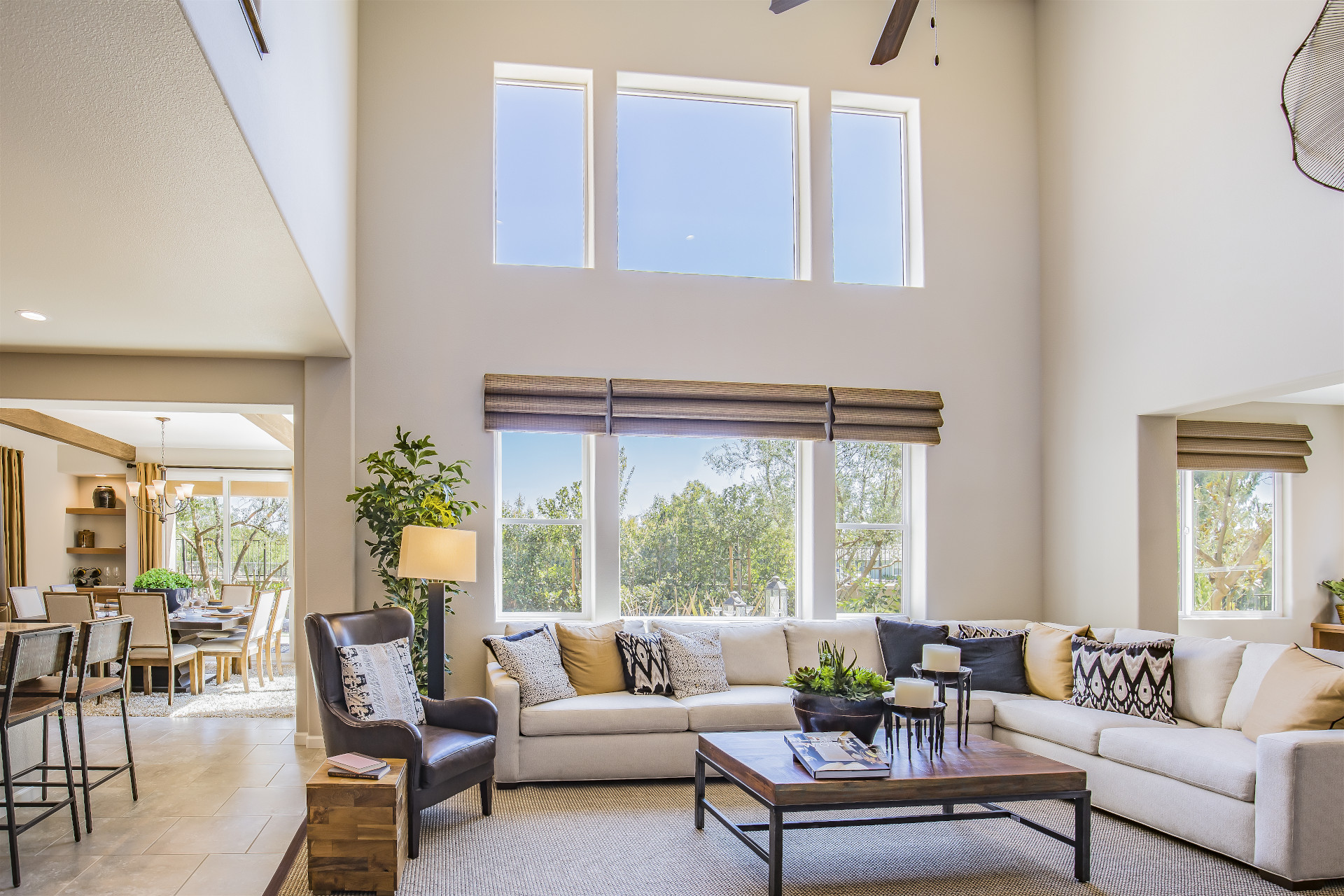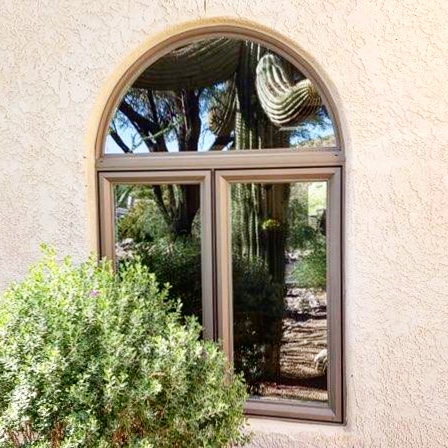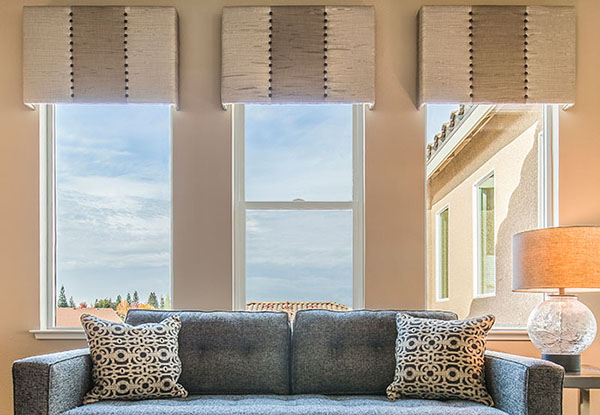With several months of warm weather each year, most Arizona residents are constantly looking for ways to keep the interiors of their homes cool—without their utility bills skyrocketing. One of the most effective ways to do this is by installing energy-efficient windows. According to the U.S. Department of Energy, up to 30 percent of heating and cooling energy use in a home is attributable to heat gained and lost through windows. Therefore, whether you are building a new home or thinking about replacing your existing windows, choosing energy-efficient options offers a particularly strong opportunity to reduce utility costs while creating a more comfortable temperature within your home.
From low-E coatings to ENERGY STAR ratings, making sense of the terminology surrounding energy-efficient windows can be confusing. The following guide offers insight into the different factors that make a window energy efficient and how to choose the best options for your home.
What makes a window energy efficient?
The main purpose of energy-efficient windows is to keep heated or cooled air inside your home, thereby minimizing energy consumption and contributing to a comfortable living environment. This goal is accomplished through three key design elements: the glass, the frame, and the style of the window.
When it comes to the glass used in a window, various factors can enhance energy efficiency. Here’s what to look for:

- Multiple panes. Double- and triple-pane windows consist of multiple sheets of glass that are separated from each other by an air-filled space, which serves to trap hot or cold air from the outside and prevent it from entering your home. While triple-pane windows may be the most efficient option in areas that experience harsh winters, double-pane tends to be the optimal choice for most climates, including Arizona. When compared to single-pane windows—which carry a lower upfront cost but contribute to higher utility costs due to a lack of insulation—the energy savings offered by double-pane windows over time can be significant.
- Low-E glass coatings. A low-emissivity, or low-E, coating is a colorless, microscopically thin, nontoxic metal or metallic oxide coating that affects the ways that the heat energy from sunlight moves around. During the warmer months, low-E coatings reflect the sun’s heat and UV rays away from the home, while reflecting them back inside during the winter. In addition to helping create a more comfortable indoor temperature throughout the year, low-E coatings also reduce the damaging effects that harmful UV rays can have on the color of your carpets, flooring, and furnishings. Low-E coatings are available with options for low, moderate, and high solar gain, and can cut energy loss by an estimated 30 to 50 percent—a savings that can significantly reduce your utility costs in the long run.
- Gas fills. Double and triple-pane windows carry the option of having a gas filler, such as argon or krypton, between the panes. These nontoxic, odorless, and colorless gases are denser than air, allowing them to serve as additional insulation against outdoor temperatures and UV rays.
Another element of a window that contributes to its energy efficiency is the frame. While it is often thought that wood frames offer the best insulation because wood does not transfer heat and cold as easily as some other materials, each type of frame carries pros and cons that may influence your energy efficiency results. At The Window & Door Store, we offer various options for window frames, each of which combines the latest energy-saving technology with custom colors and styles to suit your home’s aesthetic. Here are a few of the window frames that we offer:
- High-performance vinyl. Available with custom glass packages that are designed for maximum energy efficiency, our high-performance vinyl frames are reinforced with steel. They also carry a transferable, “double lifetime” warranty with accidental glass breakage coverage.
- With five-layer composite construction, these fiberglass windows offer unmatched strength and durability against harsh weather conditions, including the intense summer heat. They come with a long-lasting powder coat finish that resists fading and scratching.
- Wood-clad. Regardless of the style of your home, wood window frames are a timeless choice. Our wood-clad windows are available in styles ranging from traditional to contemporary, with a variety of custom stained and painted options.

A third element that can affect a window’s energy efficiency is its style. While some styles naturally offer better insulation than others, choosing options such as double-pane, low-E coated, gas-filled glass can make any window more energy efficient. Here are a few of the most common window styles:
- Double-hung. As one of the most common varieties, double-hung windows are seen in homes of various styles, but are often associated with a more traditional aesthetic. They consist of two large, frame-enclosed panels—which are subdivided into smaller panes by a grid—that open by sliding up and down within vertical tracks. Double-hung windows are efficient choices for most climates except the most extreme, where air could potentially seep in between the sliders. Other advantages of double-hung windows include a wide variety of styles to choose from, and dirt-resistant vertical tracks that tend to make it easier to open and close the windows.
- Designed to resist wind, casement windows are often considered the most energy-efficient style. They are mounted on hinges located on one side of the window and are opened by a crank that causes them to pivot horizontally, like a door. When open, casement windows can bring maximum air flow into the home, but when closed, they have a strong seal on all sides and are designed to seal themselves even more tightly when a gust of wind blows toward the house. One downside of casement windows is that their hinges and seals will require maintenance to ensure lasting integrity and energy efficiency.
- Often known as picture windows, fixed windows do not open or close, but are perfect for providing a vista or allowing natural light into a room. Since they are permanently sealed, fixed windows tend to be naturally energy efficient. In sunny Arizona, however, it may be necessary to use window shades in order to prevent natural light from heating the interior of the home. Additionally, using energy-efficient glass options becomes increasingly important with larger windows.
At The Window & Door Store, we offer these styles of windows and many others to suit your home. Regardless of the style you choose, we can make recommendations on how to maximize energy efficiency in order to keep your home comfortable and your utility bills low.
How can you tell if a window is energy efficient?
In addition to the factors mentioned above, various organizations publish guidelines that can help you assess a window’s energy efficiency. For example, ENERGY STAR, a program run by the U.S. Environmental Protection Agency, seeks to provide consumers and businesses with objective, credible information to help them choose products that will improve energy efficiency. By choosing a window certified by ENERGY STAR, you can reliably expect that it will help you lower utility costs, control the temperature in your home, and contribute to a cleaner environment by reducing greenhouse gas emissions.
Another organization that rates the energy performance of windows and other products is the National Fenestration Rating Council (NFRC). When looking at the NFRC label on a window, you will see four categories that can help you gauge how energy efficient it is:

- The U-Factor measures how effectively the product can prevent heat from escaping a room. From the range of 0.20-1.20, a lower number indicates that the product is better at keeping in heat and therefore more energy efficient.
- The Solar Heat Gain Coefficient measures how well the product can resist unwanted heat gain—which is particularly important during the warmer months. The range is zero to one; look for a rating on the lower end of that range to indicate better performance.
- Visible Transmittance measures how well a product allows natural daylight into your home, which can help you save money on artificial lighting. On a scale of zero to one, a higher number indicates that the product will let in more light.
- Air Leakage measures how much air the product will allow into a room. Look for a rating under 0.3; lower numbers indicate fewer drafts.
How much can energy-efficient windows help you save on utility costs?
While there are numerous factors that can affect how much you’ll spend on heating and cooling your home, there’s no denying that opting for energy-efficient windows will help reduce your costs. In fact, the U.S. Department of Energy estimates that by replacing older windows—particularly if they are single pane—with newer, ENERGY STAR-certified windows, you’ll be able to save between $125 and $465 per year. On average, homeowners who install ENERGY STAR windows save approximately 12 percent on utility costs over the course of the year—and that amount could be even higher depending on the climate in your area and the specific windows you are replacing. Therefore, while energy-efficient windows may carry higher upfront costs, they should more than pay for themselves over time.

Installing energy-efficient windows
While choosing a high-quality, ENERGY STAR-certified window is a crucial step in improving your home’s energy efficiency, the importance of proper installation cannot be understated. Even the best window will not deliver the expected results if it has not been installed properly, so choosing experienced, trustworthy installers is an essential part of the process.
At The Window & Door Store, our mission is to deliver a five-star experience from the moment you first visit our showroom to the day your new windows are installed. We partner with industry-leading brands, including Pella, Anlin, Provia, Heritage, and more, and can recommend the best energy-efficient windows for your home. Our highly trained and experienced installation teams will ensure that your new windows are installed properly, ensuring that you will have years of worry-free enjoyment.
Are you ready to improve the efficiency of your home and minimize your utility bills with beautiful, energy-saving new windows?
Contact us today to request a free estimate!
